











|
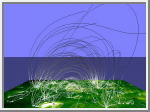
Donald Savage Headquarters, Washington, DC November 5, 1997 (Phone: 202/358-1547) EMBARGOED UNTIL 1 P.M. EST Bill Steigerwald Goddard Space Flight Center, Greenbelt, MD (Phone: 301/286-5017) RELEASE: 97-256A likely solution to one of the major mysteries of the Sun has emerged from recent observations with the European Space Agency/NASA Solar and Heliospheric Observatory (SOHO) mission.
The new findings seem to account for a substantial part of the energy needed to cause the very high temperature of the corona, the outermost layer of the Sun's atmosphere. Since the corona's temperature was first measured 55 years ago, scientists have lacked a satisfactory explanation for why that temperature is three million degrees while the visible surface of the Sun is only 11,000 degrees Fahrenheit or about 6,000 degrees Celsius.
It is physically impossible to transfer thermal energy from the cooler surface to the much hotter corona, so the energy transfer had to be in the form of waves or magnetic energy, but no measurement to date had found adequate energy to account for the coronal temperature.
"We now have direct evidence for the upward transfer of magnetic energy from the Sun's surface toward the corona above. There is more than enough energy coming up from the loops of the 'magnetic carpet' to heat the corona to its known temperature," said Dr. Alan Title of the Stanford-Lockheed Institute for Space Research, Lockheed Martin Advanced Technology Center, Palo Alto, CA, who led the research. "Each one of these loops carries as much energy as a large hydroelectric plant, such as the Hoover dam, generates in about a million years!"
"We now appear to be closing in on an explanation as to why the solar corona is over 100 times hotter than the solar surface - - the solution to a 55-year old puzzle," said Dr. George Withbroe, Director of the Sun-Earth Connection Program at NASA Headquarters, Washington, DC. "These results underline the importance of long- term study of the changing conditions on the Sun from the superior vantage point of space."
Energy flows from the loops when they interact, producing electrical and magnetic "short circuits." The very strong electric currents in these short circuits are what heats the corona to a temperature of several million degrees. Images from the Extreme ultraviolet Imaging Telescope (EIT) and the Coronal Diagnostics Spectrometer (CDS) on SOHO show the hot gases of the ever-changing corona reacting to the evolving magnetic fields rooted in the solar surface.
The observations with SOHO's Michelson Doppler Imager (MDI) provided long-duration, highly detailed, and well calibrated time- lapse movies of the magnetic fields on the visible surface or "photosphere" of the Sun. These revealed the rapidly changing properties of what Title calls "the Sun's Magnetic Carpet," a sprinkling of tens-of-thousands of magnetic concentrations. These concentrations have both north and south magnetic poles, which are the "foot points" of magnetic loops extending into the solar corona.
Like field biologists who study the populations and life cycles of animal herds, the SOHO researchers analyzed the appearances and disappearances of large numbers of the small magnetic concentrations on the solar surface. "We find that after a typical small magnetic loop emerges, it fragments and drifts around and then disappears in only 40 hours," Title said. "It's very hard to understand how such a short-lived effect could be driven by the magnetic dynamo layer that is over 100,000 miles beneath the surface of the Sun. This may be evidence that unknown processes are at work in or near the solar surface that continuously form these loops all over the Sun."
Professor Phillip Scherrer of Stanford University is the MDI Principal Investigator. MDI was built at the LM Technology Center and is a project of the Stanford-Lockheed Institute for Space Research.
The new observations were made with several instruments on SOHO, which is stationed about 900,000 miles (1.5 million kilometers) sunward of the Earth in interplanetary space, where it has an uninterrupted view of the Sun and of the solar wind particles blown from the Sun. SOHO is operated from a control center at NASA's Goddard Space Flight Center, Greenbelt, MD. SOHO was launched on Dec. 2, 1995 aboard an Atlas-IIAS expendable launch vehicle from Kennedy Space Center, FL.
| Magnetic Carpet Press Release Animations |
|---|
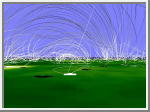 Magnetic Carpet Walk Through
Magnetic Carpet Walk Through
The complex distribution and mixing of magnetic polarities (here displayed
as black and white) form a "magnetic carpet" over the entire Sun.
The magnetic loops, connecting regions of opposing magnetic polarity, rise
far into the solar corona, forming extensive loop structures.
While the bright active regions have long been known to be
sources of heating, the diffuse heating appears to be associated with
the ubiquitous magnetic carpet.
The relationship between the structure of the magnetic carpet and the
heating of the solar corona was discovered by comparing images of the Sun taken
simultaneously by the MDI and EIT instruments on SOHO.
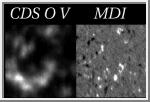 Magnetic vs. Heating Data
Magnetic vs. Heating Data
Theoretical predictions for the structure and heating of the magnetic
field above the solar surface using data for the magnetic data from
MDI are compared to the heating observed by EIT. The white magnetic
fieldlines eminate from the magnetic carpet and form arches from one
magnetic polarity (white) to the other (black). Current theories
predict that length and curvature of these arches determine the degree
to which they are heated. The image underlying the arches is the
heating observed at the same time by EIT in the Iron line at 195
Angstroms, with bright green corresponding to relatively hot regions
and dark green corresponding to cool ones.
 Magnetic Carpet Walk Through (EFR)
Magnetic Carpet Walk Through (EFR)
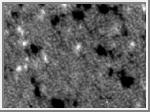 Smaller Feature Magnetic Carpet
Smaller Feature Magnetic Carpet
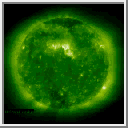 Lower Corona
Lower Corona
| Magnetic Carpet Press Release Images |
|---|

|

|
|---|---|
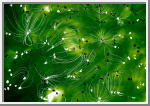
|

|
The solar corona is a region of hot, electrically charged gas streaming from the surface of the Sun. The image shows different amounts of coronal material at a temperature of about 2.7 million degrees Fahrenheit. Whiter areas represent more material at this temperature, darker areas represent less. The black and white spots represent magnetic field concentrations with opposite orientations, called polarity. Each spot is roughly 5,000 miles across. These concentrations make up the solar "magnetic carpet" that is believed to be responsible for the extreme heating of the corona.
Between pairs of opposite polarity, magnetic field connections exist, represented here by lines based on computer calculations. These horseshoe shaped loops extend above the surface into the corona. Although small relative to the Sun, they range between a few thousand to several tens of thousands of miles in length; the smallest would still fit around the Earth. Each one of these loops carries as much energy as a large hydroelectric plant, such as the Hoover dam, would generate over a million years.
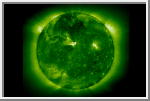 Magnetic Carpet EIT Image
Magnetic Carpet EIT Image
This is an EIT Fe XII 195 Å image showing ephemeral regions as well as post-flare
loops.
(Courtesy ESA/NASA)